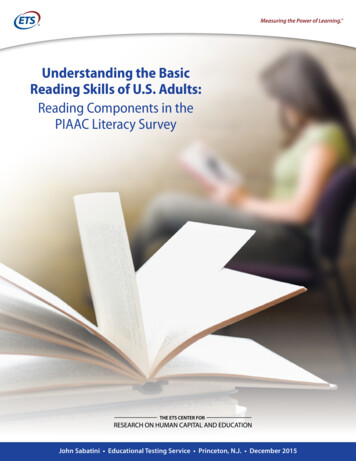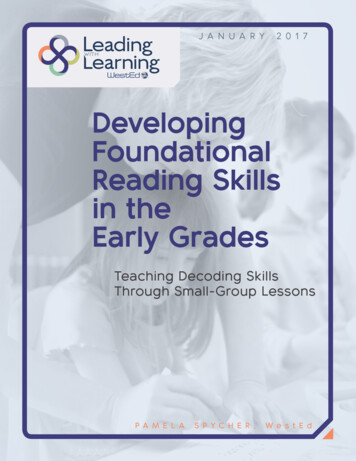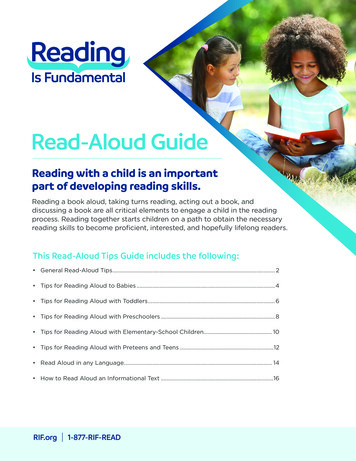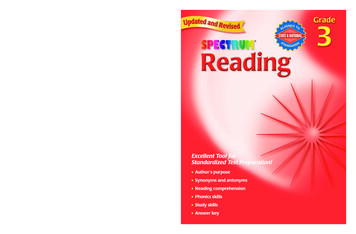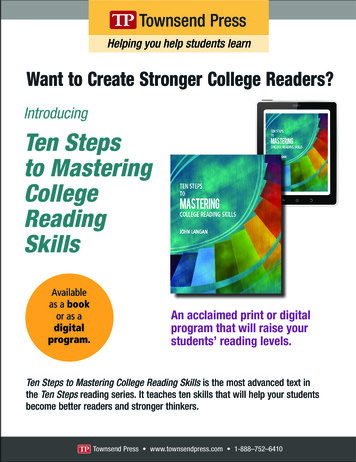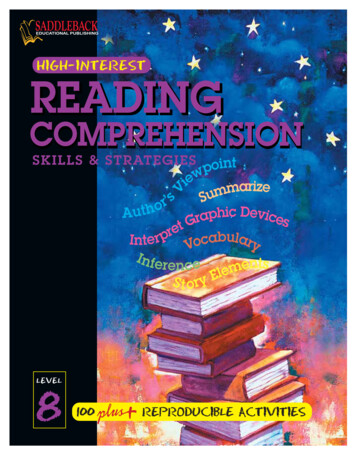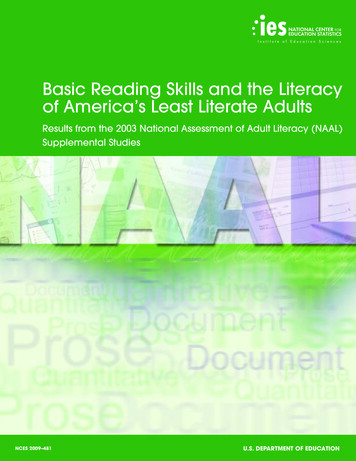
Transcription
Basic Reading Skills and the Literacyof America’s Least Literate AdultsResults from the 2003 National Assessment of Adult Literacy (NAAL)Supplemental StudiesNCES 2009–481U.S. Department of Education
Basic Reading Skills and the Literacyof America’s Least Literate AdultsResults from the 2003 National Assessment of Adult Literacy (NAAL)Supplemental StudiesFebruary 2009Justin BaerMark KutnerAmerican Institutes for ResearchJohn SabatiniEducational Testing ServiceSheida WhiteProject OfficerNational Center for Education StatisticsNCES 2009–481U.S. Department of Education
U.S. Department of EducationArne DuncanSecretaryInstitute of Education SciencesSue BetkaActing DirectorNational Center for Education StatisticsStuart KerachskyActing CommissionerThe National Center for Education Statistics (NCES) is the primary federal entity for collecting, analyzing, and reporting datarelated to education in the United States and other nations. It fulfills a congressional mandate to collect, collate, analyze, and reportfull and complete statistics on the condition of education in the United States; conduct and publish reports and specialized analysesof the meaning and significance of such statistics; assist state and local education agencies in improving their statistical systems; andreview and report on education activities in foreign countries.NCES activities are designed to address high-priority education data needs; provide consistent, reliable, complete, and accurateindicators of education status and trends; and report timely, useful, and high-quality data to the U.S. Department of Education,the Congress, the states, other education policymakers, practitioners, data users, and the general public. Unless specifically noted, allinformation contained herein is in the public domain.We strive to make our products available in a variety of formats and in language that is appropriate to a variety of audiences. You, asour customer, are the best judge of our success in communicating information effectively. If you have any comments or suggestionsabout this or any other NCES product or report, we would like to hear from you. Please direct your comments toNational Center for Education StatisticsInstitute of Education SciencesU.S. Department of Education1990 K Street NWWashington, DC 20006-5651February 2009The NCES World Wide Web Home Page address is http://nces.ed.gov.The NCES World Wide Web Electronic Catalog is http://nces.ed.gov/pubsearch.Suggested CitationBaer, J., Kutner, M., and Sabatini, J. (2009). Basic Reading Skills and the Literacy of America’s Least Literate Adults: Results from the2003 National Assessment of Adult Literacy (NAAL) Supplemental Studies (NCES 2009-481). National Center for Education Statistics,Institute of Education Sciences, U.S. Department of Education. Washington, DC.For ordering information on this report, write toU.S. Department of EducationED PubsP.O. Box 1398Jessup, MD 20794-1398or call toll free 1-877-4ED-Pubs or order online at http://www.edpubs.org.Content ContactSheida White(202) 502-7473sheida.white@ed.gov
Core Literacy Tasks and MainLiteracy AssessmentFluency Addition to NAAL (FAN)Executive SummaryThe 2003 National Assessment of AdultLiteracy (NAAL) assessed the English literacy of adults in the United States for thefirst time since the 1992 National Adult LiteracySurvey. The assessment was administered to morethan 19,000 adults (ages 16 and older) in households and prisons. The tasks included on the assessment were designed to measure functional literacy.Unlike indirect measures of literacy, which rely onself-reports and other subjective evaluations, theassessment measured literacy directly through taskscompleted by adults. These tasks represent a rangeof literacy activities that adults are likely to face intheir daily lives.Adult Literacy SupplementalAssessment (ALSA)The Basic Reading Skills ofAmerica’s AdultsThe Skills of America’s LeastLiterate AdultsThe main literacy assessment and the core literacytasks are two of the four components of the NAALproject. This report focuses on the results of theremaining two component: the Fluency Addition toNAAL (FAN) and the Adult Literacy SupplementalAssessment (ALSA). It was beyond the scope of theinitial report of the main literacy assessment, Literacyin Everyday Life: Results from the 2003 NationalAssessment of Adult Literacy (Kutner et al. 2006), toalso adequately present the results of the FAN andALSA. The results of the FAN and ALSA appeartogether in this report because both componentsaddress basic reading skills.Core Literacy Tasks and Main Literacy AssessmentMost respondents were administered the main literacy assessment, which examined the functionaliii
Basic Reading Skills and the Literacy of America’s Least Literate Adultsliteracy of America’s adults. All respondents firstattempted seven simple literacy questions, called thecore literacy tasks. Adults unable to successfully answerthe core literacy tasks were assigned to the supplemental assessment (described below); all other adults wereassigned to the main literacy assessment.Three types of literacy were measured on the mainliteracy assessment on scales of 0 to 500. Prose literacy is the knowledge and skills needed to search,comprehend, and use information from continuoustexts such as books, newspaper articles, or magazines. Document literacy is the knowledge and skillsneeded to search, comprehend, and use informationfrom noncontinuous texts, such as maps, schedules,and catalog order forms. Quantitative literacy is theknowledge and skills needed to identify and performcomputations using numbers that are embedded inprinted materials.Results from the main literacy assessment are reported as averages and as the percentage of adults in eachof four literacy levels: Below Basic, Basic, Intermediate,and Proficient. Statistical significance is reported at p .05. Differences that are not statistically significanteither are not discussed or are referred to as “notstatistically significant.”Adult Literacy Supplemental Assessment(ALSA)The Adult Literacy Supplemental Assessment wasadministered to adults unable to successfully answerthe core literacy tasks. Instead of completing themain literacy assessment, these adults completed theALSA, or supplemental assessment, which gatheredinformation about their letter-reading, word-reading, word-identification, and basic comprehensionskills. The supplemental assessment used commonproducts—such as a carbonated beverage can or abox of cold medicine—to evaluate the skills of lowliteracy adults.ivThe supplemental assessment (but not FAN) wasadministered in either English or Spanish, providinginsight into how skills differ across adults on the basisof their language background.Fluency Addition to NAAL (FAN)Whereas the main literacy assessment measures adults’abilities to comprehend and use printed texts and documents, the Fluency Addition to NAAL measures thebasic reading skills of America’s adults. Basic readingskills refer to the ability to read the elements of printedtext—letters, words, and continuous text—accuratelyand efficiently. These skills, sometimes referred to asprint skills (Strucker,Yamamoto, and Kirsch 2003), arefoundational to reading comprehension ability.Because the FAN was given to all participants, itwas possible to examine the relationship betweenbasic reading skills (collected through the FAN) andthe ability to complete prose literacy tasks (collectedthrough the main literacy assessment). This examination revealed how limitations in basic reading skills mayhinder comprehension. Moreover, because the FANwas given to adults in the ALSA population (thosewith the lowest literacy) as well as to those in the mainassessment, comparisons could be made between thebasic reading skills of adults in the ALSA populationand those in the main literacy assessment population.Key Similarities and Differences BetweenALSA and FANThe ALSA and FAN tasks were designed separately.However, there is some overlap in the basic readingskills they assess. Both require reading letters andwords aloud.The difference is in the range of abilitiescovered by the tasks and in the contextual facilitation provided by the materials. In ALSA, adults areasked to read a letter or simple word in the contextof a common product package. For many adults, theproducts are familiar and this context facilitates correct responses (see chapter 4).
Executive SummaryBy contrast, in FAN tasks, adults are asked to read awide range of letters and words presented with no additional context.The material that adults are asked to readin FAN ranges from all the letters of the alphabet andsimple words to complex words, novel words, and textpassages.They are asked to read accurately and efficiently with no contextual clues to facilitate performance.The Basic Reading Skills of America’sAdultsIn the FAN, the following research questions areaddressed: What is the relationship between proficiency levels (based on the Prose literacy scale of themain literacy assessment) and basic reading skills (i.e.,digit, letter, word, and passage reading)? How do basicreading skills vary between the ALSA population andthe main literacy assessment population? How dobasic reading skills vary among key subgroups?Results from the FAN are presented as a compositeBasic Reading Skills (BRS) score as well as by eachof the four oral fluency tasks (digit and letter reading,word reading, decoding, and passage reading) included in the assessment. All scores from the oral fluencyassessment are expressed as the number of words correctly read per minute. BRS score is not a compositescore of all the four tasks. It includes passage reading,word reading, and decoding, and excludes digit- andletter-reading. The BRS score is a simple average ofpassage reading, word reading, and decoding scorespresented as the number of words read correctly perminute. Word reading and decoding differ in that theformer required reading real English words while thelatter required reading pseudo-words or made-upEnglish words.nThe average BRS score was higher than theaverage decoding score, but lower than theaverage digit- and letter-reading, word-reading,and passage-reading scores.nnnnnThe average passage-reading scores for adultswith Intermediate and Proficient prose literacywere higher than the average digit- and letterreading scores.Approximately half (49 percent) of adults withBelow Basic prose literacy read fewer than 60words correctly per minute (i.e., at the lowestBRS level).The average BRS score for adults in the mainliteracy assessment population was 98 wordscorrectly read per minute, compared with anaverage score of 34 words correctly read perminute for adults in the supplemental assessment population.BRS scores were highest for White adults andlowest for Hispanic adults.Among adults with Below Basic prose literacyscores, 39 percent of those who spoke onlyEnglish before starting school read fewer than60 words correctly per minute (i.e., at the lowest BRS level), compared with 72 percent ofadults with a Spanish language background.The Skills of America’s Least LiterateAdultsIn the ALSA, the following research questions areaddressed: What basic functional literacy tasks canadults at the lowest level of literacy perform? Howdo key subgroups, especially native versus nonnativeEnglish speakers, differ in their ability to performthese most basic functional tasks?Results from the supplemental assessment are presented as the percentage of adults who correctly answeredthe questions included on that assessment. In addition, the characteristics of adults in the supplementalassessment population are compared with thecharacteristics of adults in the Below Basic and mainliteracy assessment populations.
Basic Reading Skills and the Literacy of America’s Least Literate AdultsnnnviThe majority of adults in the supplementalassessment population were Hispanic and amajority of adults in the supplemental assessment had educational attainment of less than ahigh school diploma or GED.A higher percentage of adults in the Englishlanguage supplemental assessment populationhad been diagnosed with multiple disabilitiesthan adults in the Spanish language supplemental assessment population.Although adults below the poverty thresholdrepresented 17 percent of adults in the nation,they represented 58 percent of adults in thesupplemental assessment population.nnThe percentage of correct responses to the letter-reading and word-reading tasks was higheramong adults in the English language supplemental assessment population than amongadults in the Spanish language supplementalassessment population.The percentage of correct responses to the wordidentification tasks was higher among adults inthe Spanish language supplemental assessmentpopulation compared to adults in the Englishlanguage supplemental assessment population.
AcknowledgmentsThe National Assessment of Adult Literacy(NAAL) is a complex project whose successful completion is due to the outstandingwork of countless individuals from many organizations. We especially want to thank the staff at theNational Center for Education Statistics (NCES)who contributed to this project. We are also grateful to the ESSI Technical Team for their review ofthe report.The Fluency Addition to NAAL (FAN) reflectsthe contributions of many individuals. The lateRichard Venezky helped guide its design andprovided invaluable support and friendship. TheFAN Technical Advisory Group—Marilyn Adams,Hollis Scarborough, and Timothy Shanahan—carefully reviewed the results and helped ground themtheoretically. Ordinate Corporation designed therecording software for the FAN and also scoredthe assessment.The Adult Literacy SupplementalAssessment (ALSA) was developed by Larry Condelli,Mike Fast, and Terry Salinger, our colleagues at theAmerican Institutes for Research (AIR). We thankthem for their hard work in designing, administering, and scoring the supplemental assessment.Our colleagues at Westat, Inc., were responsible forthe assessment’s complex sampling and weightingas well as for its data collection. We would like tothank the Westat project director, Martha Berlin,as well as Michelle Amsbary, Leyla Mohadjer, andJacquie Hogan.vii
Basic Reading Skills and the Literacy of America’s Least Literate AdultsMany staff at AIR besides the authors contributedsubstantially to this report. Elizabeth Greenberg hashelped guide the NAAL from the design throughthe reporting stages. Stéphane Baldi played a pivotalrole in the analysis and reporting of results from theFAN. Ying Jin has provided technical assistance andhelp preparing all NAAL reports. Rachel Greenbergprovided technical support in preparing the data andtext of the report and in shepherding it through thereview process. We are especially appreciative of thecontributions of Holly Baker, who edited the report,and Heather Block, who designed the report. Weviiiwould also like to thank Janan Musa for providingthe AIR team with strong administrative support.We also acknowledge the contributions of ArchieLapointe, a former member of the AIR team duringthe early stages of the NAAL, and Eugene Johnson,another former member of the AIR team, whodirected the assessment’s psychometrics and preliminary analysis activities.We also thank the thousands of adults in both households and prisons who participated in the assessment.This study would not have been possible withouttheir participation.
ContentsPageExecutive Summary. . . . . . . . . . . . . . . . . . . . . . . . . . . . . . . . . . . . . . . . . . . . . . iiiAcknowledgments . . . . . . . . . . . . . . . . . . . . . . . . . . . . . . . . . . . . . . . . . . . . . . . viiList of Tables . . . . . . . . . . . . . . . . . . . . . . . . . . . . . . . . . . . . . . . . . . . . . . . . . . . . xiList of Figures . . . . . . . . . . . . . . . . . . . . . . . . . . . . . . . . . . . . . . . . . . . . . . . . . . xivChapter 1: Introduction. . . . . . . . . . . . . . . . . . . . . . . . . . . . . . . . . . . . . . . . . . . . 1Background Questionnaire. . . . . . . . . . . . . . . . . . . . . . . . . . . . . . . . . . . . . . . . . . . . . . . . . . . . . . . 2Core Literacy Tasks. . . . . . . . . . . . . . . . . . . . . . . . . . . . . . . . . . . . . . . . . . . . . . . . . . . . . . . . . . . . . . 2Main Literacy Assessment. . . . . . . . . . . . . . . . . . . . . . . . . . . . . . . . . . . . . . . . . . . . . . . . . . . . . . . 2Adult Literacy Supplemental Assessment (ALSA). . . . . . . . . . . . . . . . . . . . . . . . . . . . . . . . . . . . 3Fluency Addition to NAAL (FAN). . . . . . . . . . . . . . . . . . . . . . . . . . . . . . . . . . . . . . . . . . . . . . . . . . 3Conducting the Survey. . . . . . . . . . . . . . . . . . . . . . . . . . . . . . . . . . . . . . . . . . . . . . . . . . . . . . . . . . 4Interpretation of Results . . . . . . . . . . . . . . . . . . . . . . . . . . . . . . . . . . . . . . . . . . . . . . . . . . . . . . . . 4Cautions in Interpretation. . . . . . . . . . . . . . . . . . . . . . . . . . . . . . . . . . . . . . . . . . . . . . . . . . . . . . . 5Organization of the Report . . . . . . . . . . . . . . . . . . . . . . . . . . . . . . . . . . . . . . . . . . . . . . . . . . . . . . 5Chapter 2: Measuring Basic Reading: The Fluency Addition to NAAL (FAN)and the Adult Literacy Supplemental Assessment (ALSA) . . . . . . . . . . . . . . . 7Fluency Addition to NAAL (FAN). . . . . . . . . . . . . . . . . . . . . . . . . . . . . . . . . . . . . . . . . . . . . . . . . . 8Adult Literacy Supplemental Assessment (ALSA). . . . . . . . . . . . . . . . . . . . . . . . . . . . . . . . . . . 10Nonliterate in English. . . . . . . . . . . . . . . . . . . . . . . . . . . . . . . . . . . . . . . . . . . . . . . . . . . . . . . . . . 13Chapter 3: The Basic Reading Skills of America’s Adults as Measured byOral Reading Fluency. . . . . . . . . . . . . . . . . . . . . . . . . . . . . . . . . . . . . . . . . . . . . 15Developing the Basic Reading Skills (BRS) Score . . . . . . . . . . . . . . . . . . . . . . . . . . . . . . . . . . . 16Measures of Basic Reading Skills. . . . . . . . . . . . . . . . . . . . . . . . . . . . . . . . . . . . . . . . . . . . . . . . . 16ix
Basic Reading Skills and the Literacy of America’s Least Literate AdultsBasic Reading Skills and Prose Literacy. . . . . . . . . . . . . . . . . . . . . . . . . . . . . . . . . . . . . . . . . . . . . . . . . . . . . . . . . . . . . . . . . . . . . . . . . . . . . . . 21Summary. . . . . . . . . . . . . . . . . . . . . . . . . . . . . . . . . . . . . . . . . . . . . . . . . . . . . . . . . . . . . . . . . . . . . . . . . . . . . . . . . . . . . . . . . . . . . . . . . . . . . . . . 27Chapter 4: The Basic Reading Skills of America’s Least Literate Adults as Measured by Adult LiteracySupplemental Assessment (ALSA) . . . . . . . . . . . . . . . . . . . . . . . . . . . . . . . . . . . . . . . . . . . . . . . . . . . . 29Characteristics of America’s Least Literate Adults. . . . . . . . . . . . . . . . . . . . . . . . . . . . . . . . . . . . . . . . . . . . . . . . . . . . . . . . . . . . . . . . . . . . . . .What the Least Literate Adults Can and Cannot Do. . . . . . . . . . . . . . . . . . . . . . . . . . . . . . . . . . . . . . . . . . . . . . . . . . . . . . . . . . . . . . . . . . . . .Letter Reading. . . . . . . . . . . . . . . . . . . . . . . . . . . . . . . . . . . . . . . . . . . . . . . . . . . . . . . . . . . . . . . . . . . . . . . . . . . . . . . . . . . . . . . . . . . . . . . . . . . .Word Identification. . . . . . . . . . . . . . . . . . . . . . . . . . . . . . . . . . . . . . . . . . . . . . . . . . . . . . . . . . . . . . . . . . . . . . . . . . . . . . . . . . . . . . . . . . . . . . . .Word Reading . . . . . . . . . . . . . . . . . . . . . . . . . . . . . . . . . . . . . . . . . . . . . . . . . . . . . . . . . . . . . . . . . . . . . . . . . . . . . . . . . . . . . . . . . . . . . . . . . . . .Comprehension. . . . . . . . . . . . . . . . . . . . . . . . . . . . . . . . . . . . . . . . . . . . . . . . . . . . . . . . . . . . . . . . . . . . . . . . . . . . . . . . . . . . . . . . . . . . . . . . . . .Summary. . . . . . . . . . . . . . . . . . . . . . . . . . . . . . . . . . . . . . . . . . . . . . . . . . . . . . . . . . . . . . . . . . . . . . . . . . . . . . . . . . . . . . . . . . . . . . . . . . . . . . . .30323434353638References . . . . . . . . . . . . . . . . . . . . . . . . . . . . . . . . . . . . . . . . . . . . . . . . . . . . . . . . . . . . . . . . . . . . . . . . . . . . . . . . . 39Appendix A: Definitions of All Subpopulations and Background Variables Reported . . . . . . . . . . . . . . . . . . 41Appendix B: Technical Notes . . . . . . . . . . . . . . . . . . . . . . . . . . . . . . . . . . . . . . . . . . . . . . . . . . . . . . . . . . . . . . . . . . 45Appendix C: Estimates and Standard Errors for Tables and Figures . . . . . . . . . . . . . . . . . . . . . . . . . . . . . . . . . . 55x
ContentsList of TablesTable2-1.3-1.PageMaterials and number of tasks included on the Adult Literacy Supplemental Assessment: 2003. . . . . . . . . . . . . . . . . . . . . . . .Correlation between Basic Reading Skills score and measures of oral reading fluency among adults, by languagespoken before starting school: 2003 . . . . . . . . . . . . . . . . . . . . . . . . . . . . . . . . . . . . . . . . . . . . . . . . . . . . . . . . . . . . . . . . . . . . . . . . . .3-2. Correlation between Basic Reading Skills score and prose, document, and quantitative literacy scores among adults:2003. . . . . . . . . . . . . . . . . . . . . . . . . . . . . . . . . . . . . . . . . . . . . . . . . . . . . . . . . . . . . . . . . . . . . . . . . . . . . . . . . . . . . . . . . . . . . . . . . . . . .3-3. Average number of words correctly read per minute among adults for Basic Reading Skills score in each prose literacylevel, by race/ethnicity: 2003. . . . . . . . . . . . . . . . . . . . . . . . . . . . . . . . . . . . . . . . . . . . . . . . . . . . . . . . . . . . . . . . . . . . . . . . . . . . . . . . .3-4. Average number of words correctly read per minute among adults for Basic Reading Skills score in each prose literacylevel, by Hispanic background: 2003 . . . . . . . . . . . . . . . . . . . . . . . . . . . . . . . . . . . . . . . . . . . . . . . . . . . . . . . . . . . . . . . . . . . . . . . . . .3-5. Average number of words correctly read per minute among adults for Basic Reading Skills score in each prose literacylevel, by language spoken before starting school: 2003. . . . . . . . . . . . . . . . . . . . . . . . . . . . . . . . . . . . . . . . . . . . . . . . . . . . . . . . . .3-6. Average number of words correctly read per minute among adults who spoke a language other than English beforestarting school for Basic Reading Skills score in each prose literacy level, by age learned English: 2003. . . . . . . . . . . . . . . . . .4-1. Percentage of adults in the supplemental assessment, Below Basic prose, and adult population by selectedcharacteristics: 2003. . . . . . . . . . . . . . . . . . . . . . . . . . . . . . . . . . . . . . . . . . . . . . . . . . . . . . . . . . . . . . . . . . . . . . . . . . . . . . . . . . . . . . . .4-2. Percentage of adults in each disability status category, by language of administration of the supplementalassessment: 2003. . . . . . . . . . . . . . . . . . . . . . . . . . . . . . . . . . . . . . . . . . . . . . . . . . . . . . . . . . . . . . . . . . . . . . . . . . . . . . . . . . . . . . . . . .4-3. Correlations between tasks included on the supplemental assessment among adults in the supplemental assessmentpopulation: 2003. . . . . . . . . . . . . . . . . . . . . . . . . . . . . . . . . . . . . . . . . . . . . . . . . . . . . . . . . . . . . . . . . . . . . . . . . . . . . . . . . . . . . . . . . . .4-4. Percentage of correct responses for letter-reading tasks among adults in the supplemental assessment population,by language of administration and familiarity with material: 2003. . . . . . . . . . . . . . . . . . . . . . . . . . . . . . . . . . . . . . . . . . . . . . . .4-5. Percentage of correct responses for word-identification tasks among adults in the supplemental assessmentpopulation, by language of administration and familiarity with material: 2003. . . . . . . . . . . . . . . . . . . . . . . . . . . . . . . . . . . . . .4-6. Percentage of correct responses for word-reading tasks among adults in the supplemental assessment population,by language of administration and familiarity with material: 2003. . . . . . . . . . . . . . . . . . . . . . . . . . . . . . . . . . . . . . . . . . . . . . . .4-7. Percentage of correct responses for comprehension tasks among adults in the supplemental assessment population,by language of administration and familiarity with material: 2003. . . . . . . . . . . . . . . . . . . . . . . . . . . . . . . . . . . . . . . . . . . . . . . .B-1. Weighted and unweighted household response rate, by survey component: 2003 . . . . . . . . . . . . . . . . . . . . . . . . . . . . . . . . . . .B-2. Weighted and unweighted prison response rate, by survey component: 2003. . . . . . . . . . . . . . . . . . . . . . . . . . . . . . . . . . . . . . .B-3. Factors and factor loadings for measures of oral reading fluency. . . . . . . . . . . . . . . . . . . . . . . . . . . . . . . . . . . . . . . . . . . . . . . . . .B-4. Score ranges and midpoints for prose literacy levels plotted in figure 3-8 . . . . . . . . . . . . . . . . . . . . . . . . . . . . . . . . . . . . . . . . . .C3-1. Estimates and standard errors for Figure 3-1. Average number of words correctly read per minute among adults,by Basic Reading Skills score and measures of oral reading fluency: 2003. . . . . . . . . . . . . . . . . . . . . . . . . . . . . . . . . . . . . . . . . . .C3-2. Estimates and standard errors for Figure 3-2. Average number of words correctly read per minute among adults forBasic Reading Skills score, by race/ethnicity: 2003. . . . . . . . . . . . . . . . . . . . . . . . . . . . . . . . . . . . . . . . . . . . . . . . . . . . . . . . . . . . . .1217212525262630323334353637474951525656xi
Basic Reading Skills and the Literacy of America’s Least Literate AdultsTablePageC3-3. Estimates and standard errors for Figure 3-3. Average number of words correctly read per minute among adults forBasic Reading Skills score, by Hispanic background: 2003. . . . . . . . . . . . . . . . . . . . . . . . . . . . . . . . . . . . . . . . . . . . . . . . . . . . . . . . 56C3-4. Estimates and standard errors for Figure 3-4. Average number of words correctly read per minute among adults forBasic Reading Skills score, by language spoken before starting school: 2003. . . . . . . . . . . . . . . . . . . . . . . . . . . . . . . . . . . . . . . . 57C3-5. Estimates and standard errors for Figure 3-5. Average number of words correctly read per minute among adults whospoke a language other than English before starting school for Basic Reading Skills score, by age learned English: 2003. . . . 57C3-6. Estimates and standard errors for Figure 3-6. Average number of words correctly read per minute among adultsfor Basic Reading Skills score and measures of oral reading fluency, by main assessment and supplemental assessmentpopulations: 2003. . . . . . . . . . . . . . . . . . . . . . . . . . . . . . . . . . . . . . . . . . . . . . . . . . . . . . . . . . . . . . . . . . . . . . . . . . . . . . . . . . . . . . . . . . 57C3-7. Estimates and standard errors for Figure 3-7. Average number of words correctly read per minute among adults in thesupplemental assessment population for Basic Reading Skills score, by language of administration for supplementalassessment: 2003. . . . . . . . . . . . . . . . . . . . . . . . . . . . . . . . . . . . . . . . . . . . . . . . . . . . . . . . . . . . . . . . . . . . . . . . . . . . . . . . . . . . . . . . . . . . . . . . 57C3-8. Estimates and standard errors for Figure 3-8. Average number of words correctly read per minute among adultswithin detailed prose literacy levels, by oral reading fluency tasks and Basic Reading Skills score: 2003. . . . . . . . . . . . . . . . . 58C3-9. Estimates and standard errors for Figure 3-9. Percentage of adults in each Basic Reading Skills level, by prose literacylevel: 2003. . . . . . . . . . . . . . . . . . . . . . . . . . . . . . . . . . . . . . . . . . . . . . . . . . . . . . . . . . . . . . . . . . . . . . . . . . . . . . . . . . . . . . . . . . . . . . . . 58C3-10. Estimates and standard errors for Figure 3-10. Percentage of adults in each Basic Reading Skills level, by proseliteracy level and language spoken before starting school: 2003 . . . . . . . . . . . . . . . . . . . . . . . . . . . . . . . . . . . . . . . . . . . . . . . . . . 58C3-11. Estimates and standard errors for Table 3-3. Average number of words correctly read per minute among adults forBasic Reading Skills score in each prose literacy level, by race/ethnicity: 2003. . . . . . . . . . . . . . . . . . . . . . . . . . . . . . . . . . . . . . . 59C3-12. Estimates and standard errors for Table 3-4. Average number of words correctly read per minute among adults forBasic Reading Skills score in each prose literacy level, by Hispanic background: 2003 . . . . . . . . . . . . . . . . . . . . . . . . . . . . . . . . 59C3-13. Es
basic reading skills of America’s adults. Basic reading skills refer to the ability to read the elements of printed text—letters, words, and continuous text—accurately and efficiently. These skills, sometimes referred to as print skills (Strucker, Yamamoto, and Kirsch 2003), are founda

